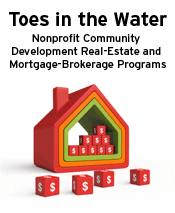
Community-based nonprofit organizations have played a major role in connecting underserved consumers and communities to competitive market services. Since the early 1990s, the community development field has made particularly dramatic strides in helping low-income and minority households, who have been traditionally underserved by the mortgage and housing market, to become first-time homeowners. Community-based nonprofit organizations have long assumed a major role in connecting underserved consumer and communities to competitive market services.
Since the early 1990s, the community development field has made particularly dramatic strides in helping low-income and minority households, who have been traditionally underserved by the mortgage and housing market, to become first-time homeowners. For the most part, nonprofits have done this through prepurchase homebuyer education and counseling, financial assistance such as down-payment and closing-cost grants and loans, development of homes that are affordable by lower-income families, and delivery of mortgage-ready borrowers to private-sector partners in the real-estate and lending industries.
A small but growing number of nonprofit organizations are beginning to move from being a partner with real-estate brokers and mortgage lenders, to entering the market on their own. The concept is simple: Many nonprofit agencies already support hundreds of families in buying homes each year. Why hand off these customers to private entities just when the financial transaction is about to be consummated?
By brokering first-mortgage loans for home purchase, a nonprofit potentially can capture the broker fee while making sure that the client receives the best possible loan. By brokering real-estate sales for clients, the nonprofit can again collect the real-estate commission while ensuring that the buyer is well served through the settlement of the transaction.
This report explores the trend of nonprofits entering the fields of mortgage and real-estate brokerage, with a focus on a state by state analysis of regulatory and other barriers which prevent nonprofit organizations from entering these markets. The authors make general policy and programmatic recommendations to improve the ability of nonprofits to provide real-estate and financial services.




Comments